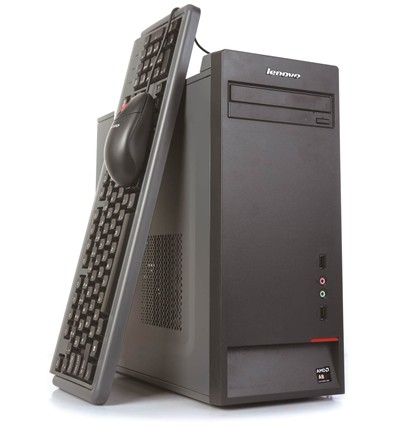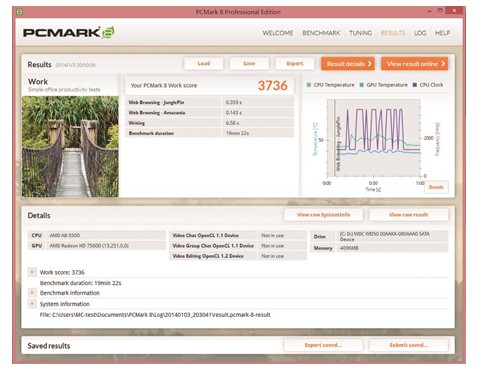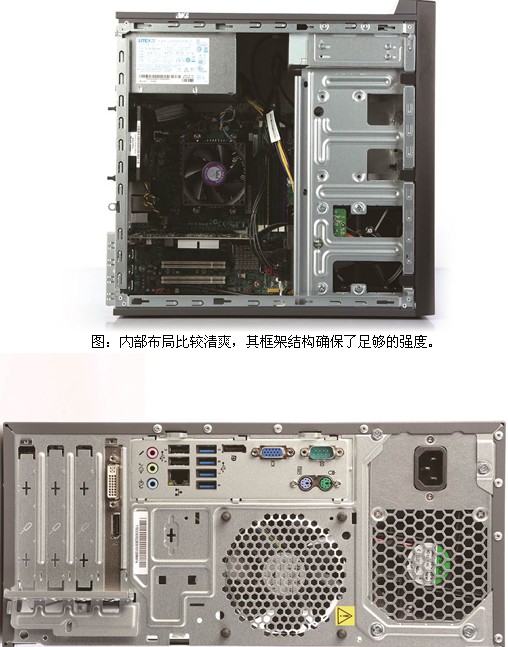We are already familiar with the Lenovo Qitian series, a commercial PC brand for the industry, corporate, government and education markets with a deep history. Because of this, when we get the Lenovo Qitian M5800-N000 with AMD APU platform, it will be full of curiosity: What changes will AMD APU bring to commercial PCs? This Qitian M5800-N000 adopts AMD A8-5500B APU+AMD Radeon HD7450 discrete graphics card configuration, this configuration is special, because the performance of the latter is actually not enough to provide too much APU with a strong display core. Add points. We suspect that the combination of this configuration is more to cater to the procurement needs of dual-graphics configurations for some industry users. What we are more concerned about is how the A8-5500B commercial APU series with the "B" suffix can bring changes to the entire commercial PC market. Overall picture Legend 1: The side panel of the fuselage can be opened. Note that this cooling window is actually located on the hard disk. Note 2: The front panel provides two USB ports and an audio interface for easy connection to mobile storage devices. In fact, the appearance of the Lenovo Qitian series is very mature, so there has not been much change over the years. Lenovo Qitian M5800-N000 Basic parameters AMD APU A8-5500B (3.2GHz, quad core) 4GB DDR3 1600 500GB SATA HDD AMD Radeon HD 7450 1GB SuperMulTI-DVD Windows 8 Advantages and disadvantages Advantages: AMD A8-5500B APU performance balanced, providing a rich interface Disadvantages: the graphics card configuration is slightly lower In fact, the A8-5500B has already been released, but the frequency of appearance in the commercial PC market is not high. After all, it is not easy to kill a bloody road in Intel's own commercial market. It belongs to Trinity APU series, has 4 processor cores and 4MB L2 cache, is manufactured in 32nm process, TDP consumes 65W, and integrates Radeon HD 7560D display core. From the specification point of view, it is basically consistent with the A8-5500 for the consumer market. In order to understand the performance of this commercial APU, after completing the basic performance test of the Qitian M5800, we removed the discrete graphics card and tested it with the APU fusion display core model. In terms of test scores, the PCMark 8 Work project scored more than 3,700 points, indicating that its performance is sufficient for the main work application. At the same time, it scored more than 3,000 points in the new 3DMark Cloud Gate, which is much higher than the Intel HD Graphics 4000 series of core graphics. Maybe users have no problem playing 3D games in their spare time. In the CineBench R15, the A8-5500B outperformed the Intel Core i5-3317U, reaching 251cb/18.97fps. Figure: In the case of the AMD A8-5500B APU alone, the 3DMark Cloud Gate score still reached 3,000 points or more. Figure: PCMark Work project test scores reached more than 4,000, and from its detailed results, the performance is fairly balanced. Edit review From the test results, AMD A8-5500B APU has a relatively balanced computing and graphics rendering capabilities, both for document editing needs, but also to provide better performance support for Photoshop image processing. Correspondingly, the Lenovo Qitian M5800-N000 with this platform also has relatively balanced performance and versatile performance, which is more suitable for more complex office jobs and environments, and becomes a more flexible choice. Lenovo Qitian M5800-N000 Figure: The power and indicator lights are located on the top of the unit. This design is suitable for placing the main unit under the table. Figure: This product is equipped with a discrete graphics card, and the interface on the back is very comprehensive.
Flexible cable, also known as flex cable or flexible flat cable (FFC), is a type of electrical cable that is made up of multiple thin and flat conductive wires. These wires are usually insulated and are arranged in a parallel configuration, allowing the cable to bend and flex easily. PVC Coated Copper Flexible Cable,Pvc Insulated Power Cables,Multi Copper Core PVC Power Cables,Copper Conductor PVC Outer Sheath Cable Ruitian Cable CO.,LTD. , https://www.rtpowercable.com




Flexible cables are commonly used in applications where space is limited or where frequent movement or flexing is required. They are often found in electronic devices such as laptops, smartphones, and cameras, where they are used to connect various components and circuits together.
The flexibility of the cable is achieved by using materials with high flexibility and low resistance to bending, such as polyimide or polyester. These materials allow the cable to bend without breaking or damaging the conductive wires inside.
Flexible cables come in various sizes and configurations, depending on the specific application. They can have different numbers of conductive wires, different widths, and different lengths. The connectors at the ends of the cable can also vary, depending on the devices or components that need to be connected.
Overall, flexible cables offer a convenient and reliable solution for connecting components in electronic devices that require flexibility and frequent movement. They provide a compact and space-saving design while maintaining good electrical conductivity.